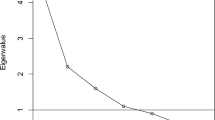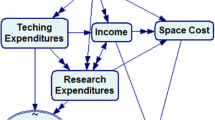Abstract
Many organizational functions, such as institutional research, assume that organizations make decisions rationally. The assumption is largely unjustified by empirical accounts of actual decision making. Higher education institutions are usually seen as political, collegial, or anarchic in their decision patterns. This study tests the participants' claim that the budget decision making process at Stanford University during the 1970s was rational. Although the study tends to support the claim, the results are neither conclusive nor comprehensive. The study provides (1) a rigorous and replicable procedure for testing the rational model, (2) evidence that rational decision making is feasible in higher education, and (3) grounds for refusing to assume pure rationality without abandoning hope of any rationality.
Similar content being viewed by others
References
Allison, G. T.Essence of Decision: Explaining the Cuban Missile Crisis. Boston: Little, Brown, 1971.
Argyris, C., and Schon, D.Organizational Learning: A Theory of Action Perspective. Reading, Mass.: Addison-Wesley, 1978.
Bouchard, T. J., Jr. Unobtrusive measures: an inventory of uses.Sociological Methods and Research 1976,4 267–300.
Campbell, D. T., and Fiske, D. W. Convergent and discriminant validation by the multitrait-multimethod matrix.Psychological Bulletin 1959,56 81–105.
Carter, E. E. The behavioral theory of the firm and top-level corporate decisions.Administrative Science Quarterly 1971,16 413–428.
Cohen, M. D., and March, J. G.Leadership and Ambiguity: The American College President. New York: McGraw-Hill, 1974.
Cyert, R. M., and March, J. G.A Behavioral Theory of the Firm. Englewood Cliffs, N.J.: Prentice-Hall, 1963.
Cyert, R. M., Simon, H. A. and Trow, D. B. Observations of a business decision.Journal of Business 1956,29 237–248.
Denzin, N. K.The Research Act (2nd ed.). New York: McGraw-Hill, 1978.
Diesing, P.Reason in Society: Five Types of Decisions and Their Social Conditions. Urbana, Ill.: University of Illinois Press, 1962; Greenwood Press, 1976.
Feldman, M. S., and March, J. G. Information in organizations as signal and symbol.Administrative Science Quarterly 1981,26 171–186.
Garfinkel, H. The rational properties of scientific and common sense activities.Behavioral Science 1960,5 72–83.
George, A.Toward a More Soundly Based Foreign Policy. Washington, D.C.: Government Printing Office, 1975.
George, A. Seminar. Institute for Research on Educational Finance and Governance at Stanford, Stanford, Calif., 24 June 1980.
Hills, F. S., and Mahoney, T. A. University budgets and organizational decision making.Administrative Science Quarterly, September 1978, 454–465.
Huber, G. P. Multi-attribute utility models: a review of field and field-like studies.Management Science 1974,20 1393–1402.
Jick, T. D. Mixing qualitative and quantitative methods: triangulation in action.Administration Science Quarterly 1979,24 603–611.
Ladd, E. C., Jr., and Lipset, S. M.1977 Survey of the American Professoriate. Storrs, Conn.: University of Connecticut, 1979.
Lindblom, C. E. The science of ‘muddling through.’Public Administration Review 1959,19 78–88.
March, J. G. Bounded rationality, ambiguity, and the engineering of choice.The Bell Journal of Economics 1978,9 587–608.
Millett, J. D.The Academic Community. New York: McGraw-Hill, 1962.
Nalbandian, J. and Klinger, D. E. Integrating context and decision strategy: a contingency theory approach to public personnel administration.Administration and Society 1980,12 178–202.
Nisbet, R. E., and Wilson, T. Telling more than we can know: verbal reports on mental processes.Psychological Review 1977,132 231–259.
Nutt, P. C. Models for decision making in organizations and some contextual variables which stipulate optimal use.Academy of Management Review 1976,2 84–98.
Operating budget guidelines for 1975–76. Stanford University, 1975.
Pfeffer, J. Management as symbolic action: the creation and maintenance of organizational paradigms. InResearch in Organizational Behavior L. L. Cummings and B. M. Staw (Eds.). Greenwich, Conn.: JAI Press, 1981.
Pfeffer, J. and Moore, W. Power and politics in university budgeting: a replication and extension.Administrative Science Quarterly 1980,25 637–653.
Pfeffer, J. and Salancik, G. R. Organizational decision making as a political process: the case of a university budget.Administrative Science Quarterly 1974,19 135–151.
Poulton, N. L. Impacts of planning activities in research universities: a comparative analysis of five institutional experiences. Doctoral dissertation, University of Michigan, 1979.
Rohrbaugh, J. Judgment analysis as policy formation: a new method for improving public participation.Public Opinion Quarterly 1978,42 521–532.
Roose, K. D., and Andersen, C. J.A Rating of Graduate Programs. Washington, D.C.: American Council on Education, 1969.
Rubin, I. Universities in stress: decision making under conditions of reduced resources.Social Science Quarterly 1977,58 242–254.
Simon, H. A. A behavioral model of rational choice.Quarterly Journal of Economics 1955,69 99–118.
Simon, H. A. Rational choice and the structure of the environment.Psychological Review 1976,63 129–138.
Simon, H. A. Rational decision making in business organizations.American Economic Review 1979,69 493–513.
Skok, J. E. Budgetary politics and decision making: development of an alternative hypothesis for state government.Administration and Society 1980,11 445–460.
Slovic, P., and Lichtenstein, S. Comparison of bayesian and regression approaches to the study of information processing in judgment.Organizational Behavior and Human Performance 1971,6 649–744.
Thompson, J. D.Organizations in Action. New York: McGraw-Hill, 1967.
Van Maanen, J. The fact of fiction in organizational ethnography.Administrative Science Quarterly 1979,24 539–550.
Washburn, W. Standards of departmental excellence: an investigation of the criteria used for judging excellence by elected departmental faculties of a research university. Doctoral dissertation, Stanford University, 1980.
Weber, Max.The Theory of Social and Economic Organizations trans. by A. M. Henderson, ed. by Talcott Parsons. Glencoe, Ill.: Free Press, 1947.
Webb, E. J., Campbell, D. T., Schwartz, R. D., and Sechrest, L.Unobtrusive Measures: Non-Reactive Research in the Social Sciences. Chicago: Rand McNally, 1966.
Weil, H. M. Can bureaucracies be rational actors? Foreign policy decision making in North Vietnam.International Studies Quarterly 1975,19 432–468.
Author information
Authors and Affiliations
Rights and permissions
About this article
Cite this article
Chaffee, E.E. The role of rationality in university budgeting. Res High Educ 19, 387–406 (1983). https://doi.org/10.1007/BF01418442
Received:
Issue Date:
DOI: https://doi.org/10.1007/BF01418442




